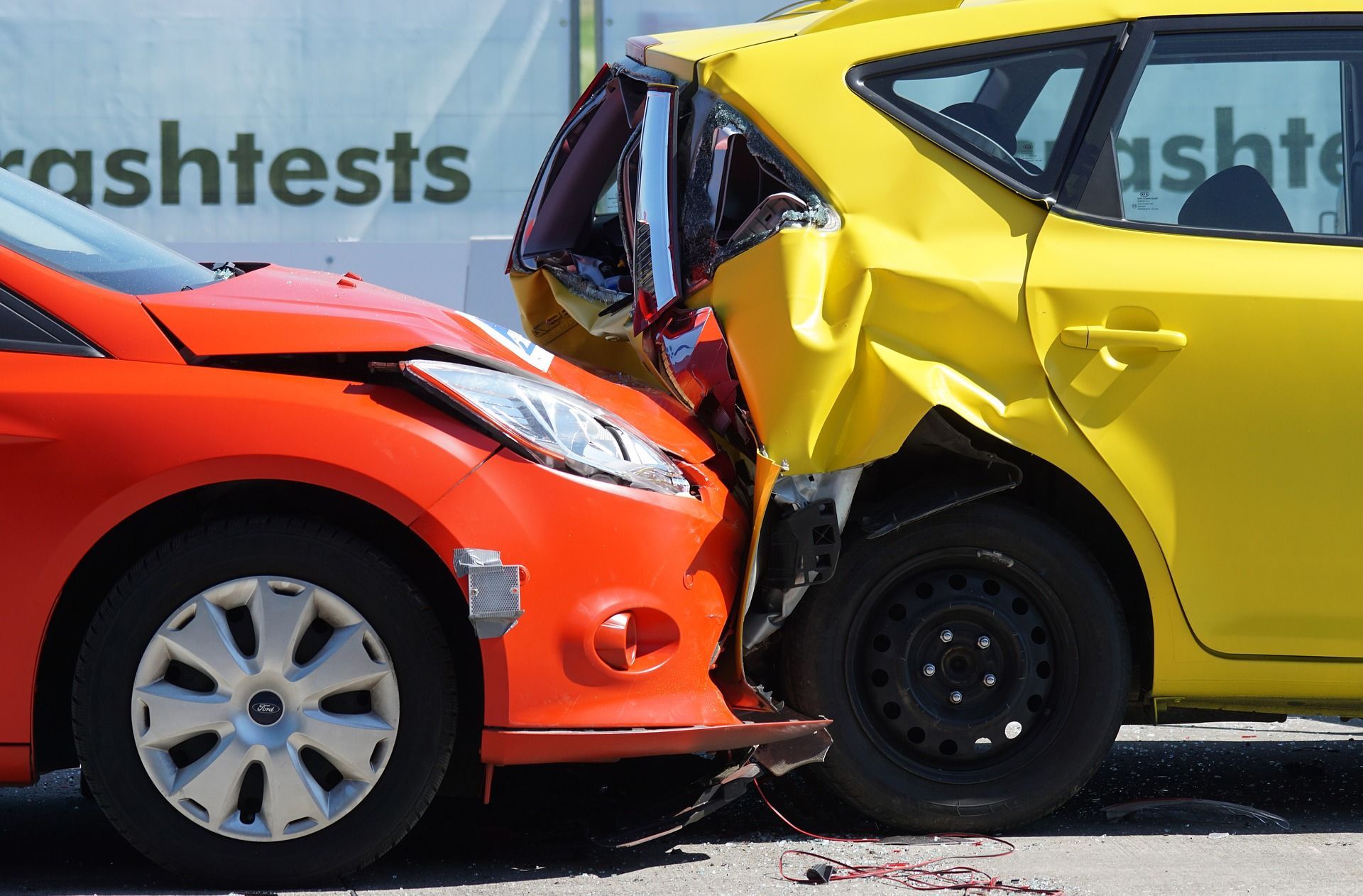Been in an Accident?
Most car accident advice articles focus on helping people who weren’t at fault in a collision. But sometimes, unfortunately, a crash is your fault - at least according to insurers.
In situations like this, what are you supposed to do? That’s the question we answer in this in-depth article. You’ll learn:
- What to do on the scene of the accident
- What to do afterwards
- How to get your vehicle repaired
So, without further ado, let’s take a look.
Call us on 01270 864358 and we can walk you through the process of getting your car booked straight in for an estimate.
Fortunately, the process you should follow is probably what you would naturally do anyway.
Step 1: Stop Your Car And Turn Off The Engine
Some types of accidents will force your car to a halt naturally, and the engine will shut off as a safety precaution. But that doesn’t always happen. If the car is still moving, find the nearest available safe place to stop and pull over. Then switch off your engine.
The law is quite clear on this matter. If you get involved in an accident, you have a legal duty to park up and remain on the scene. If you don’t, the police could charge you with an offence.
Step 2: Switch On Your Hazard Lights
The next step is to ensure your safety and that of other road users. Putting on your hazard warning lights tells other passing motorists that there’s been an incident.
Step 3: Check Yourself And Other Passengers
Accidents can result in injuries, so you’ll want to check yourself and other passengers. Most minor collisions do not cause any injuries at all. Modern vehicles are good at protecting passengers.
However, if somebody is injured, call for an ambulance immediately. If the collision blocks the road, call the police.
Step 4: Try To Remain Calm
This piece of advice might be the hardest of the bunch - trying to remain calm. If you’re struggling, try taking a few deep breaths, breathing so that your stomach expands and contracts. This method of breathing is more relaxing than inhaling higher in the chest.
Step 5: Do Not Admit Fault
The official advice from the AA is not to admit fault or responsibility for an accident until you know what happened. Sometimes, you may think you caused an accident but your perceptions might be wrong.
Step 6: Exchange Details
Exchanging entails with other drivers is important. Get their name, phone number, insurance provider and policy number. This information will help insurance companies identify who owes money to whom.
Step 7: Take Notes
Taking notes at the time of the accident is critical. Taking pictures of the scene makes it harder for parties to change their story later. What should you record, exactly?
- The date and time of the accident
- The names and contact details of drivers, passengers and witnesses (such as pedestrians)
- The driving conditions, lighting levels, and quality of the road surface
- The number plate, make and model of the vehicles involved in the accident
- The positions of the vehicles after the accident (you can take a picture of this with your phone)
- Any injuries sustained

Should You Call The Police?
If the accident is minor and you’re well away from a major thoroughfare, then you shouldn’t need to call the police immediately. Just exchange details with the other party and then call out your roadside assistance service to tow your car to a garage for essential inspections and repairs.
However, there are some situations in which you absolutely should call the police. These include:
- If the collision blocks the road and the situation is dangerous
- If you suspect that the other driver is under the influence of alcohol or drugs
- If you think that the driver caused the accident deliberately
- If the other driver leaves the scene of the accident without providing their details
- Note: You must inform the police about the accident within 24 hours. If you don’t, you could face points on your license, disqualification or a fine.
What To Do After An Accident
Eventually, roadside assistance will arrive and remove your car from the scene. What should you do next?
The law currently demands that you report the accident to your insurance company, even if you don’t want to make a claim. Furthermore, not doing so could violate the terms of your policy.
The amount of time you have to contact insurance reps varies from policy to policy. Some allow two days for a claim, while others allow a more generous two weeks. You’ll need to check how much time you have on your policy.
So what should you do after an accident you think is your fault?

Step 1: Phone Your Insurance Company Immediately
Start by phoning your insurance company. You can do this at the time of the accident as soon as you’re out of immediate danger. Again, do not admit fault. Who is to blame for a car accident is a procedural issue that insurers mainly discover themselves. When you call, your insurer will ask you for details including your policy number, postcode and registration plate number.
Then they will ask you for the details of the other drivers involved, including their names, addresses, vehicle registrations and so on. They may also ask for other drivers’ insurance details to process the situation more rapidly. You must give them as many accurate details as you can, even if you think the accident is your fault. Sometimes, you might think that you were in the wrong, but it might turn out that you’re not.
For instance, crash-for-cash claimants will often deliberately create accidents to make fraudulent insurance claims against you. They may do things like deliberately disable their brake lights so you’re more likely to go into the back of them or pretend to give way before pulling out in front of you. By doing this, they hope to take advantage of whiplash clauses in their insurance policies that force insurers to pay cash compensation on your behalf.
Victims of this behaviour often believe that they are the ones at fault. But insurance companies have powerful anti-fraud techniques that allow them to detect this type of behaviour. Being accurate and precise in your data collection can be a great way to avoid the financial ramifications of this dangerous practice.
Step 2: Provide Details And Sketches
To determine who is at fault, your insurer will ask you a series of questions and may ask you to make sketches of the accident. They will also ask to see any photos you took at the time of the accident. And they will ask for witness details - people they’ll contact later to get more data on what happened. At this point, all you should do is matter-of-factly provide factual information. It is up to the insurer how they use this information and process your claim.
Step 3: Choose Your Repairer
The next step is to choose your repairer. Usually, your insurance company will suggest somebody for you (often because they have a commercial relationship with them). However, you don’t have to go with their choice - you can choose your own.
Repairers can usually repair superficial scuffs, scrapes, and bumper damage. However, if it was a high-impact collision that damaged the core chassis, then your vehicle might be a write-off. In that case, you’ll need to inspect your insurance policy to check whether it includes “car replacement cover.” Here, the insurer promises to replace your vehicle with one with the same make, model and mileage as the original at the time of the accident. You may also have a “new for old” clause in your insurance policy. This replaces your written-off vehicle with a new model of equivalent specification.
Step 4: Continue with Your Claim
At-fault drivers don’t have to claim by law. So you still have the option of whether you want to use your insurance policy. If, however, you decide to go ahead, your insurance company will contact the other party’s insurer and come to an arrangement to resolve the claim.
If you are at fault, this will mean that your insurer will give money to the victim’s insurer who will then pass it on to the other party. If there’s a joint responsibility, then both insurers will split the costs of the claims.
Step 5: Prevent Accidents From Happening Again
The last step is to take action to prevent accidents from happening again. Here are some of the things you might like to try:
- Abstaining from driving while tired
- Avoiding driving in hazardous weather
- Going on advanced driver training courses to improve your skills
- Avoiding fiddling around with the dashboard controls while the car is in motion
- Abstaining from using your phone
Sometimes accidents just happen and there’s nothing you can do about it. But, as with all things, it pays to be prepared for the worst.
